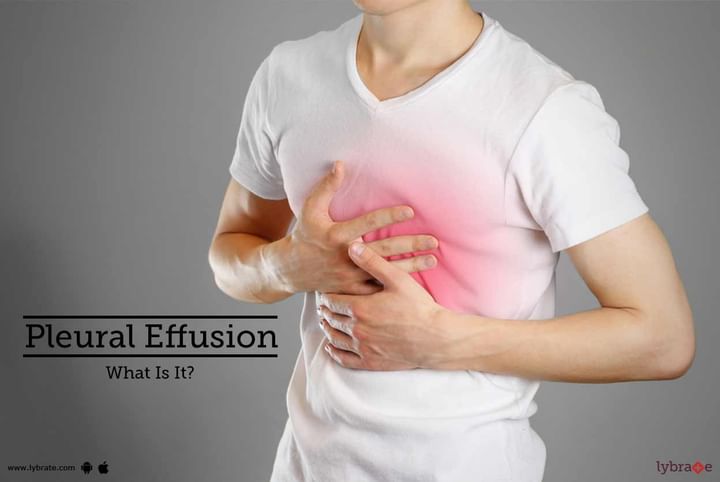Pleural Effusion - What Is It?
During breathing activity, chest wall moves out & in, lungs expand & relax. For the smooth movement of the lungs inside the chest cavity, they are lined by pleura.
Pleura includes two thin linings, the layer lining lungs is called visceral pleura and the one lining chest wall is called parietal pleura. The cavity formed between these two layers is called Pleural cavity. It contains a small amount of lubricant called Pleural fluid which helps smooth sliding of two pleural surfaces. Any condition which results in inflammation of the pleural surfaces or accumulation of excessive fluid in the pleural cavity gives rise to symptoms attributable to pleural involvement or disease.
Pleural effusion is nothing but the collection of excess fluid in the pleural cavity. Excess fluid in the pleural space is not normal and can occur due to a variety of reasons. Depending on the chemical composition it is broadly divided into two categories, transudate and exudate.
What Causes Pleural Effusion?
-
1. Transudate pleural effusions
-
Transudate pleural effusion is formed when fluid leaks from blood vessels into the pleural space. Chemically, transudates contain less protein and LDH than exudates. It is generally seen in the following conditions.
-
Congestive heart failure
-
Liver failure or cirrhosis
-
-
-
2. Exudate pleural effusions
-
Exudate pleural effusion is caused by inflammation of the pleura itself and are often due to diseases involving the lung. Following are some common illnesses giving rise to exudate pleural effusion.
-
-
- Tuberculosis
- Pneumonia
- Lung or breast cancer
- Lymphoma
- Pulmonary embolism
- Post chest wall trauma or surgery
- Asbestosis and mesothelioma
- Secondary to intra-abdominal pathology
- Pancreatic pseudocyst, etc
Symptoms of Pleural Effusion -
-
Chest Pain: Chest pain is mainly due to irritation of the pleural lining. The pain is sharp, localized and worsens with a deep breath, yawning, coughing which is usually described as pleuritic. If the effusion causes inflammation of the diaphragm the pain may be referred to the shoulder or the upper abdomen. As the pleural effusion increases in size, the pain may increase or disappear altogether due to the separation of inflamed pleural surfaces.
-
Shortness of breath: As the effusion grows larger with more fluid, the harder it is for the lung to expand and the more difficult it is for the patient to breathe resulting in shortness of breath.
-
Other Symptoms: Other symptoms are generally attributable to the underlying disease process.
Diagnosis of Pleural Effusion -
Patient’s Detailed History and Clinical Examination are the mainstays of diagnosing pleural effusion and it’s the underlying cause. Following investigative modalities are generally opted for working out the final diagnosis before instituting appropriate therapy.
- Chest X-ray: X-ray will help indicate the presence of fluid.
- Chest Ultrasound(USG): will help in confirming the presence of the fluid and it’s localization which in turn can guide the physician about its quantity and its capability.
- CT Scan: CT scan of the chest may at times be required to ascertain the underlying cause or to know about any other co-morbid conditions.
- Thoracentesis: Thoracentesis is a procedure used to sample the fluid from the pleural effusion. Using a long thin needle, fluid can be removed and sent for testing to confirm the diagnosis.
- This can be just for diagnostic purposes or can even be used as a therapeutic procedure.
- Chemical analysis of the fluid will help determine the type of pleural effusion.
Treatment of Pleural Effusion -
-
Treatment of underlying Disease: The treatment of a pleural effusion usually requires that the underlying illness or disease is treated and controlled to prevent the accumulation of the pleural fluid. Like anti-TB therapy for Tubercular etiology or treatment of Cancer in malignant pleural effusion, etc.
-
Thoracentesis: As discussed earlier Thoracentesis can be used as a therapeutic procedure to remove excess fluid and help lung expand and function properly.
-
Tube thoracostomy: Thoracostomy or chest tube insertion may be done to drain and treat fluids which cannot be removed by needle aspirations, e.g. empyemas (pus collections).
-
Pleurodesis: Some pleural effusions reoccur multiple times; sclerosing agents that induce scarring such as talc or tetracycline was used to prevent a recurrence.
-
Decortication: If sclerosing agents fail, surgery may be required, called Decortication.



+1.svg)
